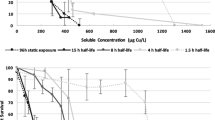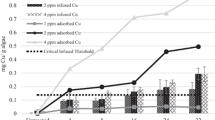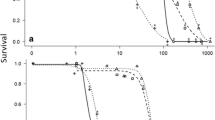Abstract
In designing aquatic herbicides containing copper, an important goal is to maximize efficacy for target species while minimizing risks for nontarget species. To have a margin of safety for nontarget species, the concentration, duration of exposure (i.e., uptake), and form (i.e., species) of copper used for herbicidal properties should not elicit adverse effects on populations of nontarget species. To determine the potential for risk or adverse effects (conversely the margin of safety), data regarding the comparative toxicity of copper-containing herbicides are crucial. A series of comparative toxicity experiments was conducted, including baseline estimates of toxicity (LC50s, LOECs), sensitive species relationships (thresholds and exposure-response slopes), and bioavailability of toxic concentrations and forms of copper 7 days after initial herbicide application. Aqueous 48-h toxicity experiments were performed to contrast responses of Daphnia magna Strauss, Hyalella azteca Saussure, Chironomus tentans Fabricius, and Pimephales promelas Rafinesque to copper herbicides: Clearigate®, Cutrine®-Plus, and copper sulfate. D. magna was the most sensitive aquatic animal tested for all three herbicides; 48-h LC50s for organisms exposed to Clearigate, Cutrine-Plus, and copper sulfate were 29.4, 11.3, and 18.9 μg Cu/L, respectively. In terms of potency (calculated from the linearized portion of the exposure-response curves, which included 50% mortality), D. magna was the most sensitive animal tested. Organisms exposed to Clearigate, Cutrine-Plus, and copper sulfate had exposure-response slopes of 2.55, 8.61, and 5.07% mortality/μg Cu/L, respectively. Bioavailability of Clearigate and Cutrine-Plus was determined by comparing survival data (LC50s) of test organisms exposed to herbicide concentrations during the first and last 48-h of a 7-day exposure period. Even in these relatively simplified water-only exposures, a transformation of copper to less bioavailable species over time was observed with a 100–200% decrease in toxicity (i.e., an increase in 48-h LC50s) for all four test animals. This series of laboratory experiments provides a worst-case scenario for determining the risk associated with the manufacturer's recommended application rates of Clearigate (100–1,000 μg Cu/L), Cutrine-Plus (200–1,000 μg Cu/L), and copper sulfate (100–500 μg Cu/L) in natural waters for four nontarget freshwater animals.
Similar content being viewed by others
Author information
Authors and Affiliations
Additional information
Received: 19 October 1999/Accepted: 13 June 2000
Rights and permissions
About this article
Cite this article
Mastin, B., Rodgers, Jr., J. Toxicity and Bioavailability of Copper Herbicides (Clearigate, Cutrine-Plus, and Copper Sulfate) to Freshwater Animals. Arch. Environ. Contam. Toxicol. 39, 445–451 (2000). https://doi.org/10.1007/s002440010126
Published:
Issue Date:
DOI: https://doi.org/10.1007/s002440010126




